 |
Supermarine
Attacker WA535 - Winwick
5th February 1953 |
 |
Supermarine
Attacker WA535 - Winwick
5th February 1953 |
Updated on 12.02.2008
As the reader may have noted from our sites diary pages, Summer 2003 saw our group widening the scope of our research, resulting in conducting our first major excavation of a post-war jet. This page tells the story of our excavation, with some photos from the dig and a brief account of how the day went.
| Type | Unit | Base | Duty | Crew | Passengers |
| Attacker FB Mk.1 | 767 Squadron | RNAS Stretton | 3rd famil flight | 1 | - |
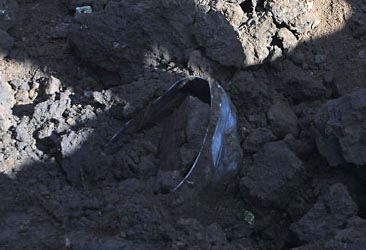 |
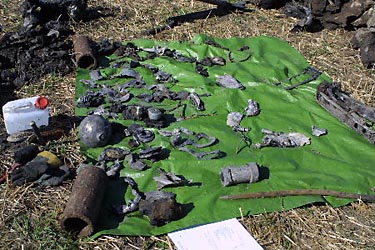 |
The stainless steel jet-pipe emerges. |
The small finds start to accumulate. |
A glorious sunny September Saturday morning saw the usual half a dozen LAIT members plus guests and an mechanical excavator :-) gather in an field at Winwick near Warrington for our first jet crash site project. Although indications from our detecting equipment were good and the Board of Inquiry report from the PRO stated that some 75% of the aircraft remained unrecovered, we were a little apprehensive as to how recognisable what was left would be. At approx. six feet down in the very sandy subsoil we uncovered the stainless steel jet-pipe and digging carefully each side of this with the excavator revealed a mass of compacted wreckage just below - soon we were finding recognisable pieces including the arrester hook, tailwheel assembly, oxygen bottles, armour plate, catapult hook, throttle levers etc.
 |
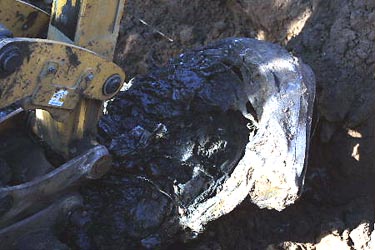 |
LAIT members check the spoil for finds as the dig progresses. |
The rear section of the engine with the jet-pipe still attached is carefully lifted clear. |
The engine proved to have shattered but the large rear section with the jet pipe still attached proved particularly awkward and very heavy. This was followed by a remarkably intact, and also very heavy, turbine wheel, sections of the turbine shaft, several flattened combustion chambers and dozens of stator blades. By now we were at a depth of some 10-12 feet and digging was halted as a couple of volunteers descended to recover the emergency dinghy which had been revealed - this was soon followed by a complete, folded exposure suit, survival rations, an intact survival manual and a parachute, still in its pack - sad reminders of the fate of the pilot. The trail of wreckage petered out at approx. 15 feet in depth and amongst the last finds were the circular nose armour plate and a large compacted mass which proved to be the instrument panels, radio and fixed nose balance weight - all literally welded together with the force of the impact.
| Name | Position | Status |
| Mr Roy Edwin Collingwood | Pilot | K. |
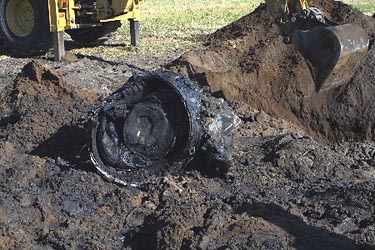 |
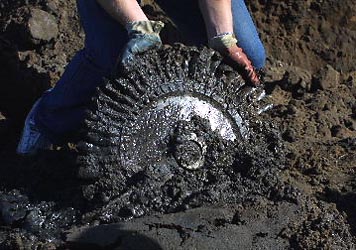 |
| The rear section of the engine was the largest item recovered. | Amazingly intact turbine disc from the engine, still coated in oil. |
WA535 took off from RNAS Stretton at 15.30 on the 5th February 1953, piloted by Mr. Roy Edwin Collingwood (22) a commissioned pilot with 767 Squadron, for his third familiarisation flight on the type. He was last heard from at 15.37 when he confirmed he was at 17,000 feet and was climbing in preparation for a high speed run. Several minutes later witnesses on the ground saw the aircraft approach the Burtonwood area at approx. 3000 feet and then go into a steep almost vertical climb to approx. 8-9000 feet. It then rolled over and went into a dive, although still giving the impression that the pilot had control, but it never pulled out and impacted vertically at high speed. Examination of the wreckage showed that the pilot had jettisoned his canopy some two miles from the point of impact and attempted to eject in the last second before impact - it was thought that he was suffering from anoxia, though no definite cause for the crash was ever decided. Roy Edwin Collingwood was buried in Holy Trinity churchyard, Southchurch, Southend-on-Sea, on 13th February 1953. He was aged 22.
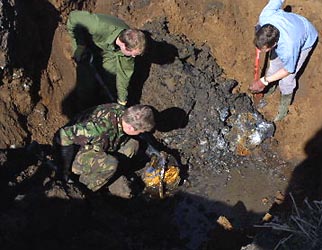 |
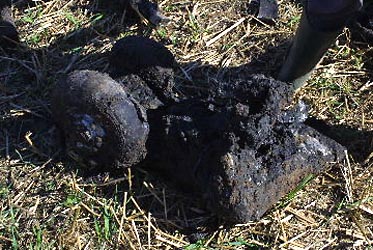 |
Carefully recovering the dinghy and parachute pack |
The Attacker's distinctive double tailwheel |
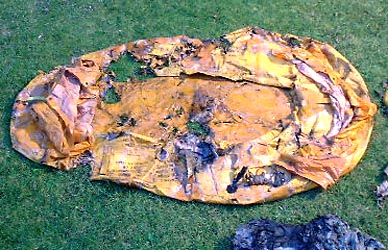 |
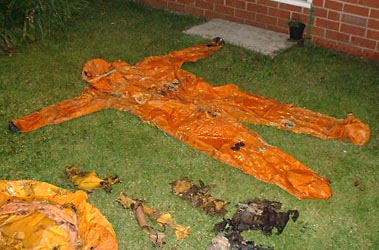 |
Once home, the dinghy was carefully unfolded and cleaned. |
The exposure suit from the survival pack unfolded and cleaned |
Mark Gaskell, Board of Inquiry report (PRO Ref. ADM1/24547), Derek Wilkinson.
This page & all articles on this site Copyright © Nick Wotherspoon 2003